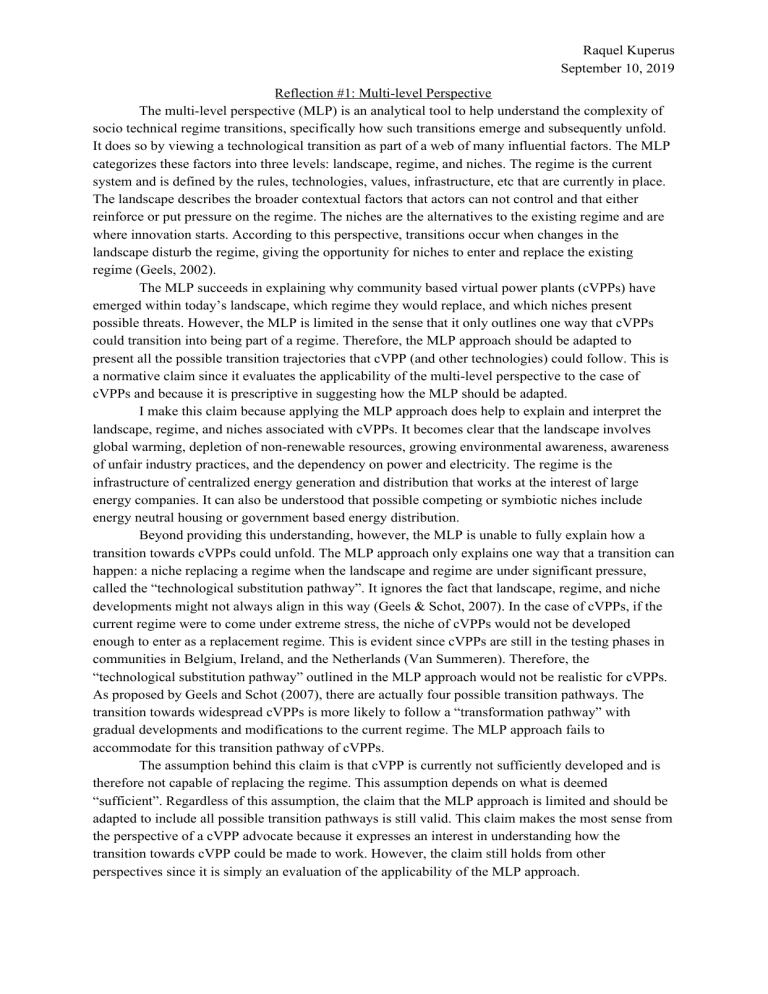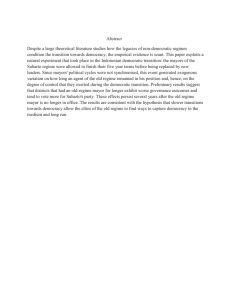
Raquel Kuperus September 10, 2019 Reflection #1: Multi-level Perspective The multi-level perspective (MLP) is an analytical tool to help understand the complexity of socio technical regime transitions, specifically how such transitions emerge and subsequently unfold. It does so by viewing a technological transition as part of a web of many influential factors. The MLP categorizes these factors into three levels: landscape, regime, and niches. The regime is the current system and is defined by the rules, technologies, values, infrastructure, etc that are currently in place. The landscape describes the broader contextual factors that actors can not control and that either reinforce or put pressure on the regime. The niches are the alternatives to the existing regime and are where innovation starts. According to this perspective, transitions occur when changes in the landscape disturb the regime, giving the opportunity for niches to enter and replace the existing regime (Geels, 2002). The MLP succeeds in explaining why community based virtual power plants (cVPPs) have emerged within today’s landscape, which regime they would replace, and which niches present possible threats. However, the MLP is limited in the sense that it only outlines one way that cVPPs could transition into being part of a regime. Therefore, the MLP approach should be adapted to present all the possible transition trajectories that cVPP (and other technologies) could follow. This is a normative claim since it evaluates the applicability of the multi-level perspective to the case of cVPPs and because it is prescriptive in suggesting how the MLP should be adapted. I make this claim because applying the MLP approach does help to explain and interpret the landscape, regime, and niches associated with cVPPs. It becomes clear that the landscape involves global warming, depletion of non-renewable resources, growing environmental awareness, awareness of unfair industry practices, and the dependency on power and electricity. The regime is the infrastructure of centralized energy generation and distribution that works at the interest of large energy companies. It can also be understood that possible competing or symbiotic niches include energy neutral housing or government based energy distribution. Beyond providing this understanding, however, the MLP is unable to fully explain how a transition towards cVPPs could unfold. The MLP approach only explains one way that a transition can happen: a niche replacing a regime when the landscape and regime are under significant pressure, called the “technological substitution pathway”. It ignores the fact that landscape, regime, and niche developments might not always align in this way (Geels & Schot, 2007). In the case of cVPPs, if the current regime were to come under extreme stress, the niche of cVPPs would not be developed enough to enter as a replacement regime. This is evident since cVPPs are still in the testing phases in communities in Belgium, Ireland, and the Netherlands (Van Summeren). Therefore, the “technological substitution pathway” outlined in the MLP approach would not be realistic for cVPPs. As proposed by Geels and Schot (2007), there are actually four possible transition pathways. The transition towards widespread cVPPs is more likely to follow a “transformation pathway” with gradual developments and modifications to the current regime. The MLP approach fails to accommodate for this transition pathway of cVPPs. The assumption behind this claim is that cVPP is currently not sufficiently developed and is therefore not capable of replacing the regime. This assumption depends on what is deemed “sufficient”. Regardless of this assumption, the claim that the MLP approach is limited and should be adapted to include all possible transition pathways is still valid. This claim makes the most sense from the perspective of a cVPP advocate because it expresses an interest in understanding how the transition towards cVPP could be made to work. However, the claim still holds from other perspectives since it is simply an evaluation of the applicability of the MLP approach. References Geels, F.W. (2002). Technological transitions as evolutionary reconfiguration processes: A multi-level perspective and a case-study. Research Policy, 31(8-9), pp. 1257-1274, http://www.sciencedirect.com/science/article/pii/S0048733302000628 Geels, F.W., Schot, J. (2007). Typology of socio-technical transition pathways. Research Policy, 36(3), pp. 399-417, www.sciencedirect.com/science/article/pii/S0048733307000248 Van Summeren, L. F. M. et al. (no date) ‘Community energy meets smart grids: Reviewing goals, ownership, and roles in community-based Virtual Power Plants in Belgium, Ireland, and the Netherlands’, Energy Research & Social Science. What is a cVPP non-published please treat confidentially.pdf
![Understanding barriers to transition in the MLP [PPT 1.19MB]](http://s2.studylib.net/store/data/005544558_1-6334f4f216c9ca191524b6f6ed43b6e2-300x300.png)





